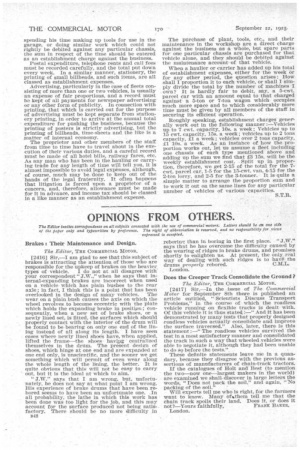OPINIONS FROM OTHERS.
Page 26

If you've noticed an error in this article please click here to report it so we can fix it.
The Editor invites Correspondence on all subjects connected with the use of commercial motors': Letters should be on one side of the paper only and typewritten by Preference. The right of abbreviation is reserved, and no responsibility for views expressed is accepted.
Brakes : Their Maintenance and Design.
The Editor, THE COMMERCIAL MOTOR.
[2416] Sir,—I am glad to see that this subject of brakes is attracting the attention of those who are responsible for the upkeep of brakes on the heavier types of vehicle. I do not at all disagree With your correspondent " J.W.," when he says that internal-expanding brakes are incorrect when used on a vehicle which has plain bushes to the rear axle ; in fact, I think this is a point that has been overlooked in the design of many vehicles. The wear on a plain bush causes the axis on which the wheel revolves to become eccentric with the plate which holds the expanding brake in positipn ; consequently, when a new set of brake shoes, or a newly lined set, is fitted, the surfaces which should properly contact with the interior of the drum will be found to be bearing on only one entl of the lining instead of all along its length. I have seen cases Where newly lined shoes have, when applied, lifted the frame—the shoes, having centralized themselves in the drum. The present design of shoes, which hinge at one end and are expanded at one end only, is unscientific, and the sooner we get something which will permit of even wear along the whole length of the *fling, the better. It is quite obvious that this Will not be easy to carry out, but it is the ideal at which to aim.
" J.W." says that I am wrong, but, unfortunately, he does not say at what point I am wrong. His experience of brake drums that have been rebored seems to have been an unfortunate one. In all probability, the lathe in which this work has been done was too light for the job, and this may account for the surface produced not being satisfactory. There should be no more difficulty In B42 reboring: than in boring in the first place. " J.W." says that he has overcome the difficulty caused by the wearing of ridges in brake drums, and promises shortly to enlighten us. At present, the only real Way of dealing with such ridges is to have the drums properly rebored. C.M.L. London.
Does the Creeper Track Consolidate the Ground ?
The Editor, THE CO*HERCIAL MOTOR.
[2417] Sir,—In the issue of The Commercial Motor for September 8th there is published an article entitled, " Scientists Discuss Transport Problems," in the course of which the roadless vehicle running on flexible tracks is dealt with. Of this vehicle it is thus stated :—" And it has been demonstrated by many tests that properly designed -roadless vehicles actually consolidate and improve the surface traversed." Also', later, there is this statement :—" The roadless vehicles survived the test in a most satisfactory manner and consolidated the track in such a way that wheeled vehicles were able to negotiate it, although they had been unable to do sq before the tests.". These definite statements leave me in a quandary, because they disagree with the previous assertions of manufacturers of chain-track tractors.
If the catalogues of Holt and Best (to mention the two—now one—largest makers in the world) are examined we shall discover in large letters the words, "Does not pack the soil," and again, "No packing of the soil."
Will experts tell me who is right, for the farmers want to know. Many otathem tell me that the chain track spoils their land. Does it, or does it not?—Yours faithfully, FRANK BARER. London.




























